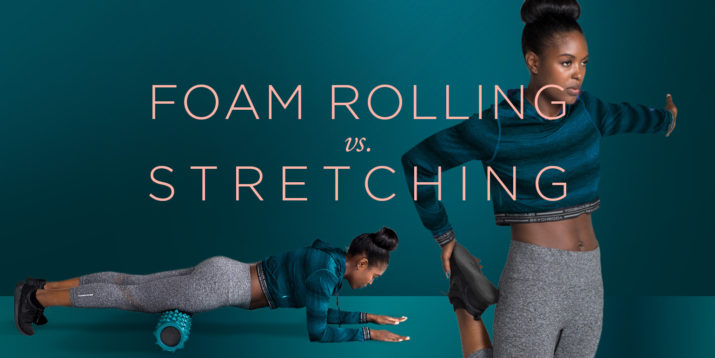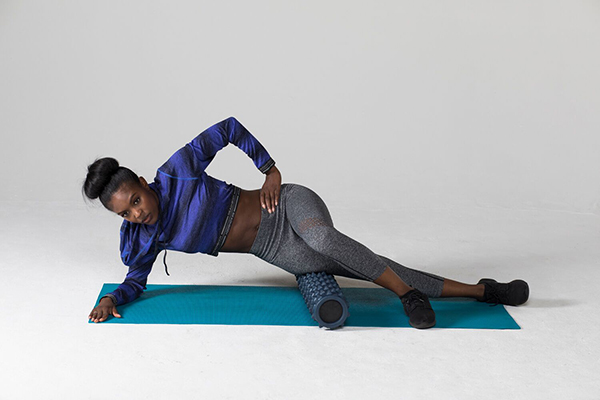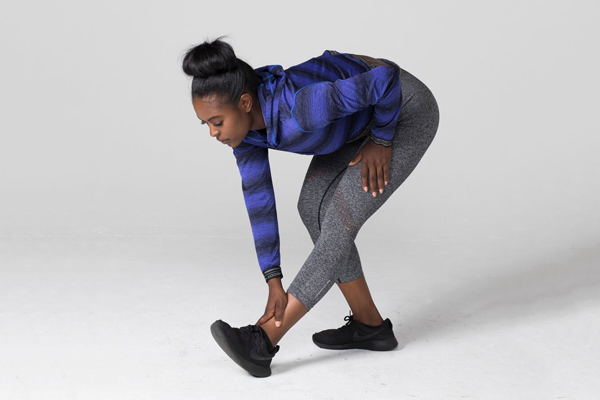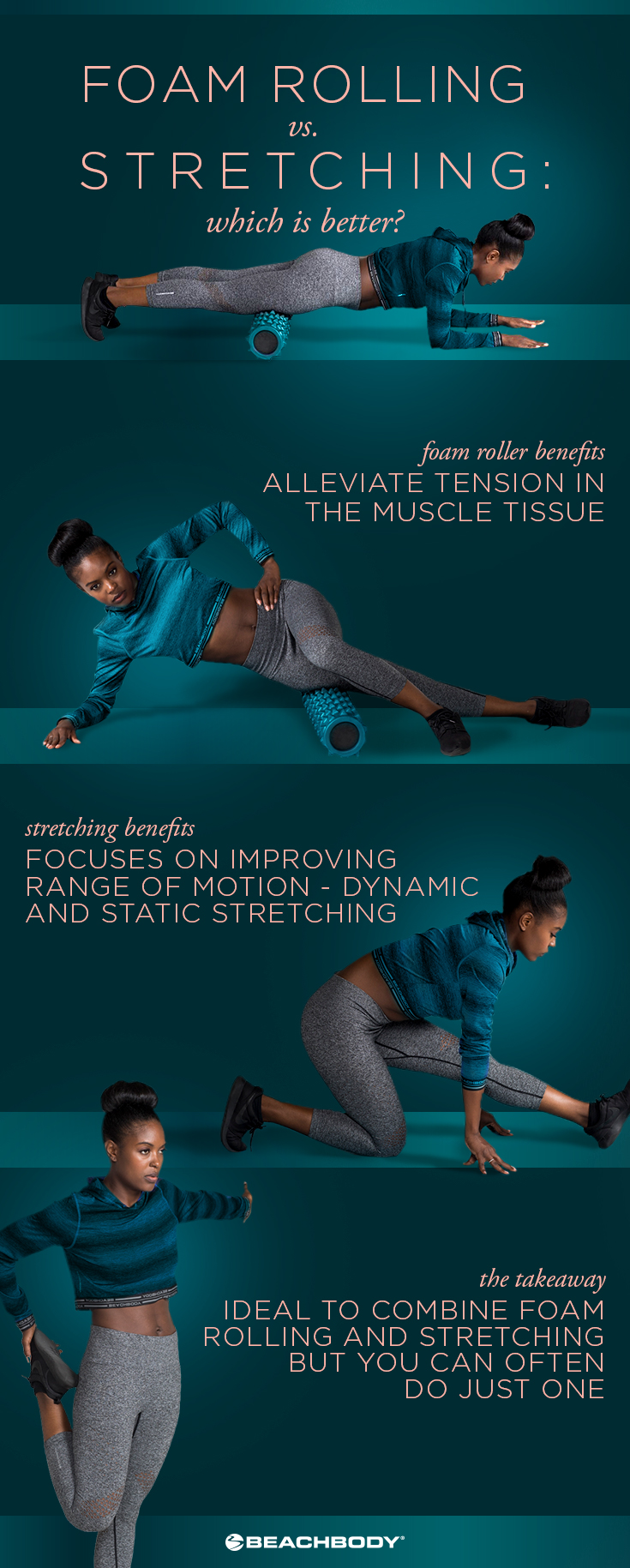Foam Rolling vs. Stretching: Which Is Better?

Adding foam rolling and stretching exercises to your routine may seem like a lot, given that it’s hard to do even a 30-minute workout most days. But thanks to the many benefits of foam rolling and stretching, doing both can give your body and your workouts a boost, provided you do them at the right times.
Benefits of Foam Rolling
The primary benefit of foam rolling is to alleviate tension in the muscle tissue.
“If you have any little restrictions like scar tissue, fascia, or trigger points, regular self-myofascial release can help release those adhesions and soften the tissue,” explains Debra Stroiney, Ph.D., professor of sport and exercise science at Gannon University.
Foam rolling does this, in part, by increasing blood flow to the area you are rolling.
“When you roll your muscles, you are pushing blood away, and then after, it wants to rush in,” says David Behm, Ph.D., university research professor, applied neuromuscular physiologist, and sports scientist at Memorial University of Newfoundland.
The combination of relieving tension and increasing blood flow provides benefits both before and after a workout.
Not exactly sure how to foam roll? Follow this guide for a breakdown of how to use a foam roller, and how not to use a foam roller.
Benefits of Stretching
The benefits of stretching and foam rolling overlap a bit, but the primary goal of stretching is to increase flexibility.
“Whereas foam rolling is intended to release and regenerate the fascia and underlying muscles, stretching focuses on improving range of motion by specifically addressing tissue extensibility, training the body for the controlled elongation of muscles during movement,” explains Jessica Matthews, author of Stretching to Stay Young and senior adviser for health and fitness education for the American Council on Exercise.
The resultant increase in flexibility may reduce your risk of injuries. “When you are better able to go through a full range of motion as your body is intended to, that leads to better movement patterns and quality, both during workouts and in everyday life,” Matthews says.
Stretching can be confusing, however, because there are two kinds of stretching exercises: dynamic and static.
Dynamic stretching takes your joints and muscles through a full range of motion, such as trunk rotations, arm circles, and hip circles.
Static stretching involves passively holding a stretch. Each provides different benefits and is best performed at different times during your workout.
The Best Time for Foam Rolling

Foam rolling isn’t only for the days you exercise. It’s also great to do on rest days.
“Doing it on a daily basis isn’t going to hurt you. If anything, the people I know have felt better because of it,” Stroiney says. Since the increasing blood flow can help your muscles recover, it can be a huge help for your recovery days.
The only time you may not want to foam roll is if you are injured. You could do more damage, so check with your health care provider before rolling an area that’s in pain.
Foam rolling before a workout
Foam rolling during a warm-up literally warms up your muscles because of the increased blood flow.
“Foam rolling is a whole-body thing,” Stroiney says, which prepares you for your workout.
Additionally, research shows that foam rolling for as little as five to 10 seconds increases range of motion, though rolling for longer leads to greater benefits. Plus, it provides these benefits without affecting performance during your workout, whereas static stretching before a workout can actually decrease power or performance, Behm explains.
And, despite the “hurts so good” reputation foam rolling has, it doesn’t need to hurt. On a scale of one to 10, where 1 is no discomfort at all and 10 is severe discomfort, rolling at an intensity of seven out of 10 gives the same benefits as rolling at an intensity of nine, according to Behm.
“You can roll moderately and still get the same effects,” he says.
Stroiney recommends doing five to 10 minutes of foam rolling as part of your warm-up. Behm says rolling an area for 30 to 60 seconds is best, but listen to your body; if an area needs extra attention, focus on that and roll it longer.
Foam rolling after a workout
Post-workout foam rolling also has benefits. Studies have found that foam rolling following exercise can reduce delayed-onset muscle soreness (DOMS).
“The increased blood flow helps bring nutrients to your muscle tissue, so you recover faster,” Stroiney explains. “The blood brings anti-inflammatory properties to the area, which may help you not be as sore later on.”
This may also help reduce the risk of injury, especially if you tend to have tight muscles or trigger points; providing release will help your muscles function better, she adds.
When you foam roll as part of a cooldown, take more time than the pre-workout foam rolling. Stroiney suggests dedicating one to two minutes to roll out each muscle group you used.
“Think of it like if a professional massage therapist were doing a full-body release for you,” she says. “You are just doing a smaller piece of that.”
Look at a massage therapist like a dentist, and foam rolling is like brushing your teeth. It’s a preventative task, and more convenient than a massage, which unfortunately doesn’t always fit your schedule and budget.
The Best Time to Stretch

As with foam rolling, stretching shouldn’t be something you only do on workout days. The ACSM recommends stretching at least two to three days a week.
Dynamic stretching is great to do in the morning to prep your body for the day, or anytime of day to re-energize, Matthews says. Get up from your desk and do a few stretches during the afternoon to bust you out of your lull.
If you want to do static stretching, always warm up your muscles first. You can do this by foam rolling, dynamic stretching, or even taking a hot bath or shower.
“It has the same effect on your muscles and tendons, making them more pliable,” Matthews says. “You can even create an evening ritual and do some static stretching after [showering] as you’re watching TV.”
If you have an injury, however, stretching that body part anytime may not be advisable.
“If your muscle is damaged, it’s trying to recover,” Behm explains, by scar tissue filling in the tears. “Stretching is pulling apart those tissues, plus if there is inflammation, your capillaries are damaged, and stretching may further damage those. Give them a few days of rest.”
Pre-workout stretches
The intention of a warm-up is to gradually prepare your body for the exercise that’s to follow. Because of this, dynamic stretching is most ideal pre-workout to increase your body temperature and heart rate.
These stretches can mimic movements or exercises in your workouts, Matthew says, like the standing hip hinge (pushing your hips back) as preparation for squats. This helps prepare your nervous system and gets your brain-body connection going. Dynamic stretches should also stretch your muscles through movement, such as leg swings for the hamstrings, or walking quad stretches.
And studies show dynamic stretching is better than static before a workout to boost power, anaerobic performance, and acceleration and speed.
Static stretching does the opposite. Research has shown that doing static stretches before a workout may reduce muscle strength by 24 percent and muscle endurance by 28 percent, and also reduce jump performance and decrease speed.
Before a workout, five to 10 minutes of dynamic stretching is ideal, but as little as three minutes will do the trick, Matthews says.
You should always do dynamic stretches for your ankles, hips, shoulders, and thoracic spine, as these areas are designed to be really mobile. Then, do movements specific to your workout. Think: Are there “rehearsal” movements you can do at half-depth and slower speed?
Post-workout stretches
After a workout is when static stretching comes into play. Your body is warm and your muscles are more pliable, which is an ideal situation for static stretching.
The American College of Sports Medicine (ACSM) advises holding each stretch 10 to 30 seconds. Then, repeat it until you’ve held each stretch for an accumulated 60 seconds. That can seem like an eternity, so to make this easier, Matthews suggests using your breath.
“Fifteen seconds is about five to six slow, controlled breaths,” she says. Move into your stretch and hold that position to the point of mild tension or slight discomfort for at least five breaths. Then repeat this four times.
Aim for 10 minutes of post-workout static stretching of all your major muscle groups, Matthews recommends. If that’s too much, “even one 15-second rep [per major muscle group] is better than zero,” Matthews adds.
Naturally, hit the muscles you’ve just worked, but also think about what else you do throughout the day that could potentially create stiffness, impact your posture, and affect your movement quality. Stretch those areas too, such as the hip flexors, which tend to be tight since we all spend so much time sitting.
As a bonus, this can be very relaxing. “Static stretching can help alleviate physical tightness in the body, and pairing it with mindful breathing can help decrease psychological stress too,” Matthews says.
When You Should Foam Roll and Stretch
Foam rolling and stretching are great alone, and they also make a great couple — if you have time, of course.
In a small study publishing in the International Journal of Sports Physical Therapy, adolescent athletes did foam rolling, static stretching, or foam rolling followed by static stretching. All three techniques increased ankle mobility, but combining the two led to a greater effect. Similarly, a study by U.S. researchers of 40 adults found that doing both led to greater increases in range of motion in the hips.
If you decide to do both, follow the study protocols and foam roll before stretching. If you’re short on time, experts say to foam roll before your workout, focusing on particularly tight and tense areas of your body. Then post-workout, do static stretches since your core body temperature is increased and your muscles are warm. And if you’re ambitious, try foam rolling later in the evening, say when you’re Netflixing.
If you have time to do both before and after exercise, follow this formula: Pre-workout, roll tight or restricted areas to prep your body for the greater movements you’ll do in your dynamic stretches, Matthews recommends. Post-workout, foam roll first, as it will help you stretch further in your static stretches.

